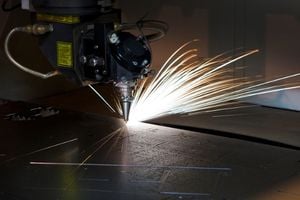What is Laser Cutting and How Does it Work?

October 11, 2021
Laser cutting machines offer a fast, clean way to cut intricate patterns and shapes into steel and other metals, wood, and plastics. It is used in the manufacturing sector to create parts for a huge range of products from giant industrial washers to fingernail sized battery holders and everything in between.
The Laser Cutting Process
A high-power laser is used to cut shapes into sheet metal and other materials as designed by a CAD/CAM machine. A laser beam is channelled as instructed by the computer-based design package to ensure the cut perfectly matches the design plans. This beam melts or burns away the part to be cut, leaving a clean edge which in some situations doesn’t even additional finishing.
Advantages of Laser Cutting
Speed and Accuracy
The clearest advantages of using a laser cutting machine is improved speed and accuracy over manual cutting. When it comes to projects which require the same cut repeatedly or multiple identical products, a laser cutting running on a CAD/CAM program will offer unrivalled accuracy to exceptionally fine tolerances.
Laser cutting machines operate at high speeds no matter how simple or complex the task in hand. The increased speed with which a laser cutter operates helps to reduce lead times, create more efficient processes and production lines and deliver significant financial and time savings.
Consistency and Quality Assurance
Creating a clean, smooth edge, laser cutters can make the same precise cut time after time with no variation. This benefit also improves quality assurance and reduces time spent in QA checks.
Decreased Waste
Laser cutters such as those owned and operated by Dudley Industries perform complex cutting tasks every day, on large sheet metal panels. Planning projects in advance to maximise sheet usage means multiple parts for multiple projects can be cut at the same time, reducing waste and lead times.
Flexibility
Another benefit offered by laser cutting is the fast set up procedure which enables the laser cutter to quickly and accurately produce any size batch of laser cut product, giving greater flexibility and reducing operational costs.
What is Laser Cutting Used For?
Laser cutting is a versatile method of cutting and creating products and is equally of use for simple and more complex projects, and batches of any size.
Commonly laser cutting machines are used by sheet metal contract manufacturing companies to create parts and shapes which are more detailed and complex. They are also employed to carry out high volume tasks requiring highly accurate repeated parts.
What Materials are Suitable for Laser Cutting?
Fibre laser cutters such as those used by Dudley Industries are commonly used to cut:
- Stainless steel
- Mild steel
- Corten steel
- Aluminium
They may be used to cut other metals such as copper and brass, which are a little harder to work with but can still achieve the same finish if cut at slower speeds.
Other materials which may be cut by a laser cutting machine include foam, plastics, MDF, and wood.
What Finishes can Laser Cutting Achieve?
While laser cutters achieve highly complex and precise finishes, to within 0.05mm typically, there are limitations on the level of complexity which can accurately be achieved. These limitations apply when dealing with thicker metals and materials. In contract manufacturing services, the rule of thumb is that cut-outs need to be at least the same size as the material thickness.
As an example, you would be unable to laser cut a 3mm hole in a 6mm thick sheet of metal (although this could be achieve by a different method), but you could cut a 3mm hole in a 3mm sheet of metal.
At What Point in a Project Should a Client Approach a Contract Manufacturing Company?
As with so many things, the best point to enquire about sheet metal contract manufacturing services is at the start of your project.
Clients producing goods and saleable products will often speak to our product design experts at the beginning of a project, their input can be highly valuable and make the project more efficient. They can participate in discussions and help avoid common delays and stumbling blocks, as well as offer unique solutions for the contract manufacturing process which reduce waste and save money.
Designers may be able to offer advice on choice of material, the design itself, the method of assembly and much more.
What Happens to the Product After Laser Cutting?
Once a product or part has been laser cut there are a range of finishes and other operational works which may be carried out. These may include:
- Folding
- Adding inserts inc. studs and nuts
- Welding
- Dressing corners
- Powder coating
An example of extra operations in action comes from a recent sheet metal contract manufacturing project for a trim panel. After a complex pattern had been cut into a steel sheet, it was folded into a ‘U’ shape to accommodate the space in which it will finally sit and had a safety fold applied to both side edges to create a smooth and safe edge. Next, weld studs were added to the underside of the piece to act as spacers and the product was then linished by our robot to provide the perfect surface for powder coating which will also be carried out on site at Dudley Industries.
Start a Conversation with Dudley Industries to Discuss Your Next Project
With years of experience, Dudley Industries can support you in delivering a high-quality bespoke sheet metal fabrication project from design to prototype to manufacture offering precise finishes to suit your project requirements. If you would like more information on our professional laser cutting services, speak to the team today for guidance and advice, who will be happy to discuss your individual project requirements.